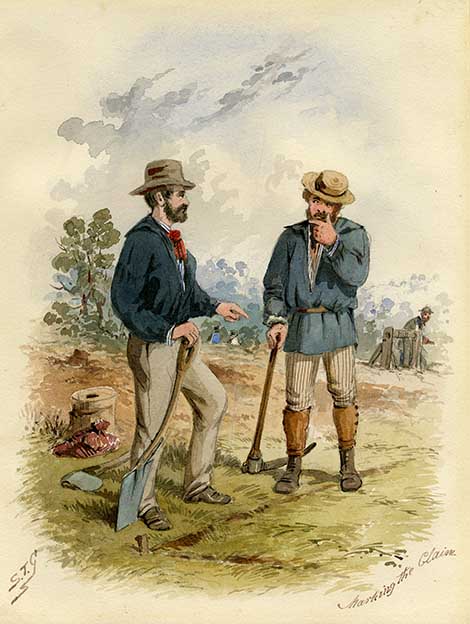Ballarat Local Court
- On the 14th of July, 1855, James Ryce, Robert Donald, Carboni Raffaello, John Yates, William Greene, Edward Milligan, John Wall, Thomas Chidlow, and Henry R. Nicholls were chosen—at a meeting of the diggers near Lalor's stump, the old trysting place daring the previous year's agitation—to serve in the first Local Court granted under the reformed regime. These courts were the first fruits of the reform movement. They were presided over by war dens of the gold-fields,—the Gold commissioners with a new name and smaller powers,—and the members and electors of the courts were men holding miner's-rights, documents issued annually in lieu of the old license. The Local Courts had power, not only to make local regulations, but to sit as absolute and unappealable courts of judicature upon cases brought under the regulations they framed. This was a fatal error in constitution, and in the course of time the defect became generally apparent, and led eventually to the abolition of the Local Courts and the creation of the Mining Boards as at present existing. The first sitting of the first Ballarat Local Court was on the 20th July, 1855, and the last sitting of the last court was on the 30 th April, 1857. Mr Warden Sherard being the first chairman. To him soon succeeded Mr Warden Daly, who filled the office as long as the court existed.
Court System in Victoria
The Court System in Victoria is complex. The Supreme Court heard the most serious cases such as murder. It also heard appeals from the lower courts. The County Court & Court of General Sessions dealt with less serious cases, and the Court of Petty Sessions, dealt with things of a petty nature, as the name implies, such as disputes between parties and the regulation of local laws. Since 1969 Courts of Petty Sessions have been known as Magistrate’s Courts.
The first magistrate for the Ballarat district was Mr Eyre, who sat at Buninyong, where the first courts were held. The first attorney was Adam Loftus Lynn who began his practice in Ballarat on 1 May 1853. Mr Richard Ocock joined Mr Lynn’s practice towards the end of the year of 1853.
The first County Court & Court of General Sessions, in this locality, was opened at Buninyong by Judge Wrixon, in January 1853, with Mr. Francis Greene as clerk of the peace.
Ballarat and Ballarat East were two separate municipalities, until the amalgamation of the two councils in 1921. This may cause confusion, because today the area is now known as City of Ballarat. Before 1922 the two municipalities had their own councils, courts, rates and bye-laws.
The Court of Petty Sessions, Ballarat East, was gazetted on 7 September 1857. On 23 September 1857, the Town Clerk of Ballarat East was instructed to write to the Attorney General for “the Appointment of a Clerk of Petty Sessions” and “to supply the council with books and necessary documents for the opening of the Court of Petty Sessions”. Both Mr. E. C. Bell, who was appointed the Clerk of Petty Sessions, on 15 March 1858, and William Collard Smith, who was appointed Magistrate on 11 October 1858, served both Ballaarat and Ballaarat East Municipal Districts. The Courts of Petty Sessions, Ballarat East, closed on 31 October 1921, with the amalgamation of the two municipalities.[1]
Members of the Ballarat Local Court
Also See
--Clare K. Gervasoni (talk) 21:37, 4 July 2015 (AEST)
- ↑ Dorothy Wickham, Court in the Act, Self Published 1998
